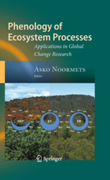
Phenology of ecosystem processes: applications in global change research
Noormets, Asko
Terrestrial carbon balance is uncertain at the regional and global scale. A significant source of variability in mid-latitude ecosystems is related to the timing and duration of phenological phases. Spring phenology, in particular, has disproportionate effects on the annual carbon balance. However, the traditional phenological indices that are based on leaf-out and flowering times of select indicator species are not universally amenable for predicting the temporal dynamics of ecosystem carbon and water exchange. Phenology of Ecosystem Processes evaluates current applications of traditional phenology in carbon and H2O cycle research, as well as the potential to identify phenological signals inecosystem processes themselves. The book summarizes recent progress in the understanding of the seasonal dynamics of ecosystem carbon and H2O fluxes, the novel use of various methods (stable isotopes, time-series, forward and inversemodeling), and the implications for remote sensing and global carbon cycle modeling. Each chapter includes a literature review, in order to present the state-of-the-science in the field and enhance the book’s usability as an educational aid, as well as a case study to exemplify the use and applicability of various methods. Chapters that apply a specific methodology summarize the successes and challenges of particular methods for quantifying the seasonal changes in ecosystem carbon, water and energy fluxes. The book will benefit global change researchers, modelers, and advanced students. INDICE: Introduction.- Section I: The Seasonal Dynamics of Ecosystem C andH2 O Exchange: Links Between Aboveground and Belowground Processes of Respiration As Affected by Phenology.- Partitioning ER to Ra and Rh.- Evapotranspiration and Energy Partitioning.- The Timing of Seasonal Transitions in GEP and ERin a Hardwood and Conifer Chronosequence, and the Effect of Moisture Dynamics.- Interannual Variation in Spring and Fall Transitions in ET and NEE.- Delineating Phenological Signal in Time-Series Data.- Upper vs. Understory Phenologyand its Significance for H2 O and C Exchange.- Seasonal and Annual Variation in Ecosystem Photosynthesis and Respiration in a Grassland of the Northern Great Plains.- Section II: Remote Sensing Phenology: Overview of the Basics of Index Development, Successes, Challenges. Goals and Compromises; Integration of Scales.- Local Heterogeneity and Validating Remote Sensing Phenology Indices.-The Applicability of MODIS Phenology Indices, Strengths and Weaknesses.- Synthesis – State-of-the-Science and Remaining Challenges.- Index.
- ISBN: 978-1-4419-0025-8
- Editorial: Springer
- Encuadernacion: Cartoné
- Páginas: 299
- Fecha Publicación: 01/07/2009
- Nº Volúmenes: 1
- Idioma: Inglés
